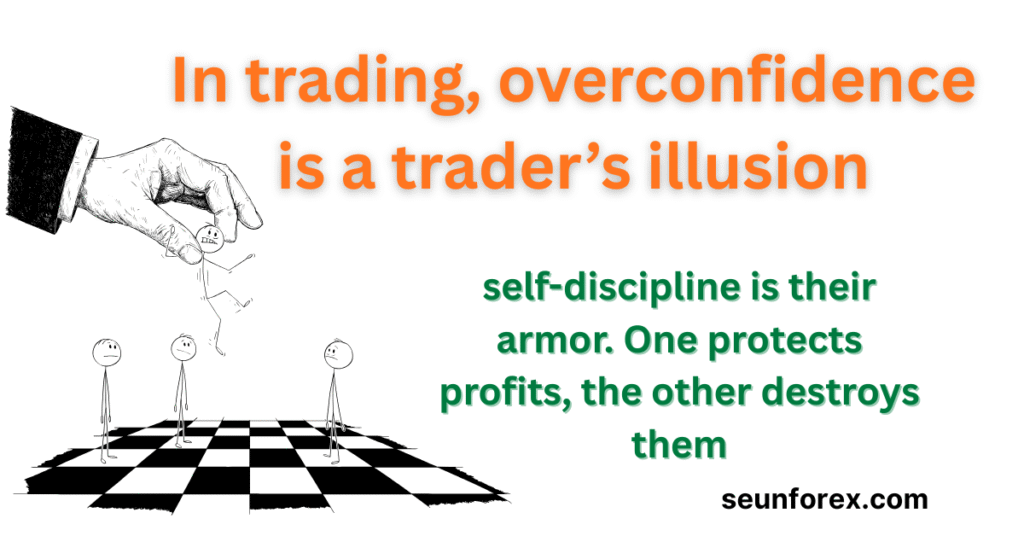
Demo vs Real Trading and Trading Psychology: The Hidden Trap 🌟
If you’ve spent hours in demo trading, you know the feeling: winning streaks, flawless execution, feeling in control. You might even start believing you’ve “cracked the code.”
Then comes live trading. Everything changes. Wins don’t come as easily. Losses feel heavier. Fear creeps in. Confidence fades. Overconfidence turns into hesitation. The strategies that worked in demo suddenly seem ineffective.
This is not a reflection of your technical skills—it’s the psychological and environmental realities of real trading. Demo trading tests strategy; live trading tests discipline, patience, and emotional control. Bridging the gap between the two is one of the hardest challenges a trader will face.
📈 The Three Key Differences Between Demo and Real Trading 🆚
The core differences are straightforward but profound. Understanding them is the first step toward bridging the gap.
1. Risk and Emotional Pressure 💥
In a demo account, losses are just numbers. Your brain doesn’t interpret them as real danger. Emotions are muted. You make logical, disciplined decisions.
In live trading, every dollar on the line triggers the brain’s fear-and-reward system:
- Fear of Loss: Hesitation before entering trades, premature exits, and overprotective stop adjustments.
- Greed: After wins, overtrading, holding onto positions too long, and chasing unrealistic profits.
Even the best strategy can fail if emotions override logic.
2. Market Conditions and Slippage 🏃♂️
Demo accounts are designed to give traders a smooth and idealized experience. They simulate perfect execution conditions that make trading feel easy:
- No slippage: Trades fill at exactly the price you want.
- Instant fills: Orders execute immediately, regardless of size.
- Minimal spreads: Entry and exit costs appear almost zero.
Live markets, however, are much messier:
- Slippage: Prices can move between order placement and execution, causing entries or exits at less favorable levels.
- Liquidity: Less popular instruments may fill partially or with delays, affecting your trade size and strategy.
- Volatility: Market news or sudden events can cause rapid swings, hitting stops unexpectedly.
- Broker differences: Real spreads and execution speeds vary, unlike the consistent demo experience.
Key takeaway: Demo trading shows a smooth, idealized version of the market, but real trading requires adapting to slippage, liquidity, and volatility. Understanding this gap is essential for risk management and strategy execution.
Without experiencing these realities, a trader can feel disoriented when moving from demo to live trading.
3. Self-Discipline and Overconfidence 💪

A long demo winning streak can give a false sense of mastery. Overconfidence develops. You might believe your strategy is flawless.
Live trading often shatters this illusion. The first loss triggers:
- Revenge Trading: Trying to win back losses impulsively
- Second-guessing: Ignoring your rules due to doubt
- Strategy Abandonment: Emotional reactions override planning
Discipline, not strategy, differentiates profitable live traders from failing ones.
📖 My Personal Trading Tale: Lessons From the Trenches
I spent months trading a $100,000 demo account flawlessly, thinking I had mastered the art of trading. Every trade felt perfect. Then I switched to live trading, and the reality of demo vs real trading hit me hard. Anxiety surged instantly. The first loss felt catastrophic. I overtraded, second-guessed every move, and watched gains vanish.
This experience taught me that demo vs real trading isn’t about charts or technical indicators—it’s about trading psychology. Your mind determines whether a strategy succeeds or fails. Patience, resilience, and discipline are far more important than any technical skill. Without mastering trading psychology, even the best strategies that worked in demo accounts fail in live markets.
Understanding the gap between demo vs real trading helped me see that emotional control, mindset, and mental preparation are critical. The charts don’t change, but your mental state does—and that makes all the difference in converting demo success into real trading profits.
Key takeaway: Mastering trading psychology is essential to bridging the gap between demo vs real trading. Your mind, not just your strategy, drives your results.
🔑 Step-by-Step Plan to Bridge the Demo-Live Gap
Transitioning requires a structured, deliberate approach. Here’s a full roadmap.
1. Start Small in Real Trading 💵
- Fund a micro account you can afford to lose.
- Trade micro lots (0.01 standard lot) to minimize emotional pressure.
- Treat every trade as a lesson in discipline, not profit.
Case Example:
A trader moved from a $100k demo account to a $200 micro account. His first few losses triggered anxiety—but because the monetary risk was small, he could focus on process rather than outcome. Within 3 months, his discipline improved, and he gradually increased position sizes.
2. Keep a Trading Journal 🖊️
Document every trade:
- Entry and exit reasoning
- Emotional state before, during, after the trade
- Trade result
- Lesson learned
Benefits:
- Reveals emotional triggers
- Highlights recurring mistakes
- Measures consistency with your plan
A journal turns experience into actionable knowledge.
3. Simulate Real Trading in Your Demo 🔄
Make demo trading feel like live trading:
- Apply real spreads and slippage
- Trade micro positions
- Set time limits and risk constraints
- Pretend every dollar lost is real
This builds mental resilience for the live market.
4. Mindset Training 🧠
Meditation
- 5–10 minutes before and after trading
- Reduces cortisol, improves focus, prevents panic decisions
Visualization
- Imagine executing trades calmly under pressure
- Mentally rehearse losses, wins, and recovery
Positive Affirmations
- Replace “I will lose this trade” with “I trust my strategy and manage risk carefully”
Emotional Checklists
- Pre-trade: Am I fearful or greedy?
- Post-trade: Did I follow the plan? Did emotion influence my exit?
5. Develop a Trading Routine ⏱️
Consistency in routine reduces mental errors:
- Analyze markets at the same time daily
- Plan trades, record setups in journal
- Limit trading hours to avoid fatigue
- Review trades and reflect emotionally
Routine Example:
- Morning: News scan and technical analysis (30–60 min)
- Pre-trade meditation (5 min)
- Trade execution following strategy
- Post-trade review and journal update (15 min)
⚠️ Common Mistakes Traders Make During Transition

- Overleveraging – Emotional reactions magnify losses.
- Ignoring Real Market Conditions – Spreads, slippage, and liquidity create unexpected outcomes.
- Trading Without a Plan – Gut decisions lead to inconsistent results.
- Letting Emotions Dictate Trades – Fear and greed override logic.
- Neglecting Journals – Patterns and mistakes go unnoticed.
Awareness of these mistakes helps you prevent them before they destroy your confidence.
📊 Advanced Psychological Strategies for Live Trading Mastery
1. Emotional Conditioning
- Practice micro-losses in demo
- Accept losing trades as natural
- Reduce fear of stop-loss triggers
2. Mental Simulation of Worst-Case Scenarios
- Simulate losing streaks in demo
- Train calm decision-making under pressure
3. Mindfulness and Stress Management
- Focused breathing techniques
- Short meditation sessions
- Avoid trading while emotionally reactive
4. Habit Formation
- Follow the same pre-trade, trade, post-trade routine
- Reinforce positive trading behaviors
- Break negative habits (overtrading, revenge trades)
🔍 Case Studies: Traders Who Bridged the Gap
Case Study 1: “The Overconfident Demo Trader”
- Problem: Relied on a long demo-winning streak
- Solution: Simulated real conditions, kept a journal, started with micro accounts
- Outcome: Built emotional discipline, trades became consistent
Case Study 2: “The Fearful Trader”
- Problem: Hesitated on every trade
- Solution: Visualization, small positions, emotional journaling
- Outcome: Confidence grew, losses were managed, consistent execution emerged
Case Study 3: “The Overleveraged Impulsive Trader”
- Problem: Took large positions after demo success
- Solution: Reduced lot size, implemented strict risk management, reviewed trades daily
- Outcome: Losses minimized, strategy consistently executed, profit slowly recovered
🔹 Key Takeaways for Bridging the Demo-Live Gap ⚡
- Acknowledge Emotional Impact: Fear and greed are unavoidable. Recognize them.
- Follow Your Strategy: Discipline is more important than profits.
- Start Small: Begin with manageable risk to focus on psychological mastery.
- Simulate Real Trading in Demo: Make your demo environment mirror real-market conditions.
- Journal Every Trade: Self-reflection strengthens discipline.
- Develop Mental Resilience: Meditation, visualization, and affirmations prepare your mind.
- Create Consistent Routines: Reduces fatigue and impulsive decisions.
🌱 Closing Thoughts: Mastering the Transition
Transitioning from demo to live trading is a rite of passage. It tests your emotional resilience as much as your technical skills and your understanding of trading psychology.
Demo accounts teach mechanics.
Live trading teaches trading psychology, mindset, and emotional control.
Emotional mastery and discipline are the differentiators.
Every great trader has faced this challenge.challenge. The difference lies in preparation, mindset, and incremental exposure to risk.
“The trader who masters their mind can master the markets.”
💡 Bonus: 30-Day Demo-to-Live Mastery Plan
Week 1–2: Micro trades in a demo account under real conditions. Journal every trade.
Week 3: Transition to micro live trades. Focus on process over profit.
Week 4: Gradually increase lot size while maintaining emotional control. Reflect daily.
Ongoing: Review journal weekly, refine strategy, maintain meditation and visualization practice.
By the end of 30 days, you will have trained both your skills and your mind to handle live trading stress.
For a more detailed roadmap on your first year of forex trading, including step-by-step strategies and mindset tips, check out our comprehensive guide here: First Year Forex Trading Guide – it’s packed with actionable tips to help you confidently transition from demo to live trading.